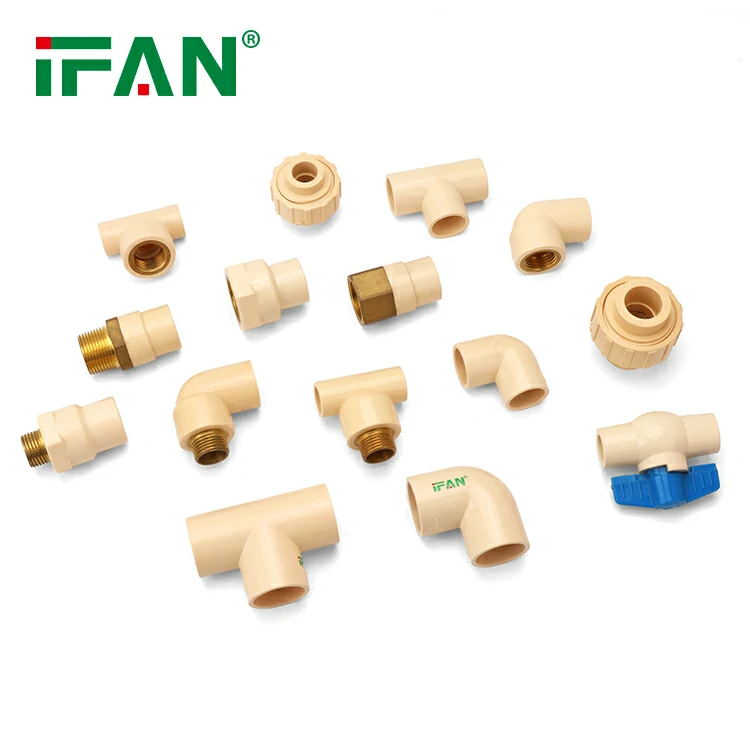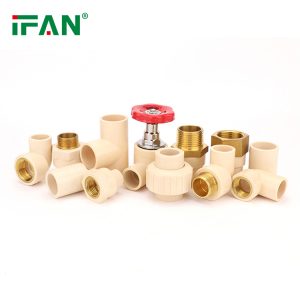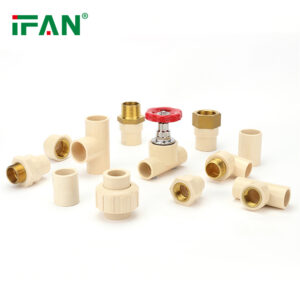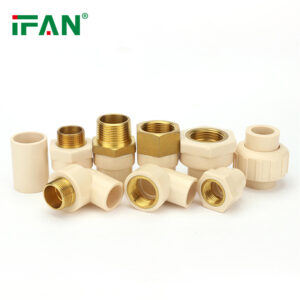
ASTM2846 CPVC Fittings for Residential Plumbing: A Smart Choice
Whatsapp Us
Share
Description
IFAN factory 30+ years manufacture experience support color /size customization support free sample.Welcome to consult for catalog and free samples.This is our Facebook Website:www.facebook.com,Click to watch IFAN’s product video.Compared with Tomex products, our IFAN products from quality to price are your best choice, welcome to buy!
In residential plumbing, the materials used for piping play a critical role in the efficiency and longevity of a plumbing system. CPVC fittings (Chlorinated Polyvinyl Chloride) have emerged as a preferred choice for homeowners and plumbers alike, offering a combination of durability, cost-effectiveness, and ease of installation. This article delves into the reasons why CPVC fittings are an excellent option for residential plumbing, highlighting their benefits, performance, and advantages over traditional piping materials.
What Are CPVC Fittings?
CPVC fittings are plumbing components made from a type of plastic polymer known as Chlorinated Polyvinyl Chloride. CPVC is similar to PVC but has been treated with chlorine, giving it the ability to handle higher temperatures. CPVC fittings are used in both hot and cold water distribution systems and are an ideal choice for residential plumbing. They are available in various shapes, such as elbows, tees, and couplings, ensuring flexibility in plumbing installations.
Key Advantages of CPVC Fittings in Residential Plumbing
1. Durability and Longevity
CPVC fittings are designed to be highly durable, offering resistance to corrosion, scaling, and pitting. Unlike metal pipes, which are susceptible to rust and degradation over time, CPVC does not corrode or degrade under normal conditions. This makes CPVC fittings an excellent long-term investment for homeowners, as they are less likely to need frequent repairs or replacements, saving both time and money.
2. Heat Resistance
One of the standout features of CPVC fittings is their ability to withstand higher temperatures than regular PVC. CPVC can handle water temperatures of up to 200°F (93°C), making it suitable for both hot and cold water applications in residential plumbing systems. This ability to resist heat without compromising structural integrity makes CPVC a superior choice for water heating systems.
3. Cost-Effectiveness
CPVC fittings are more affordable than metal alternatives such as copper or brass. Additionally, CPVC pipes are lighter and easier to transport, which reduces shipping costs. The lower material cost, coupled with easy installation, makes CPVC fittings an economical choice for residential plumbing projects. Homeowners can enjoy long-term savings due to the low maintenance and long lifespan of CPVC systems.
4. Resistance to Chemicals
CPVC fittings are highly resistant to a variety of chemicals, including acids, bases, and salts. This resistance makes CPVC ideal for use in environments where water may contain harsh chemicals or contaminants. Whether it’s the water supply in a home or the possibility of exposure to water treatment chemicals, CPVC ensures that your plumbing system remains intact and functional.
5. Easy Installation
The installation of CPVC fittings is straightforward, and it requires fewer tools compared to metal pipes. Unlike copper or steel, which require welding or soldering, CPVC can be easily joined using solvent cement. This makes the installation process quicker, cleaner, and safer. Homeowners or plumbers can efficiently install CPVC fittings without the need for special training or extensive labor.
6. Lightweight and Flexible
CPVC fittings are significantly lighter than metal alternatives, which makes them easier to handle during installation. This lightweight nature also reduces strain on the plumbing system, especially in large homes with long piping runs. The flexibility of CPVC allows it to bend slightly without cracking, providing ease of installation in tight spaces or areas with limited access.
7. Energy Efficiency
CPVC pipes and fittings contribute to energy efficiency in residential plumbing systems. The material has excellent insulating properties, reducing heat loss in hot water lines. This means that water stays hotter for longer, reducing the energy required to heat it. For homeowners, this translates to lower energy bills and a more environmentally friendly home.
8. Recyclability
CPVC is a recyclable material, which adds an environmental benefit to using it in residential plumbing. While CPVC pipes and fittings may not be as widely recycled as other materials like PET (plastic bottles), they can still be recycled at specialized centers. This contributes to reducing the overall environmental impact of construction and plumbing waste.

Comparing CPVC Fittings to Other Plumbing Materials
CPVC vs. Copper
While copper has long been a standard for residential plumbing, it comes with several downsides. Copper pipes are expensive and can be prone to corrosion, especially in areas with high acidity or mineral content in the water. In contrast, CPVC is more affordable, resistant to corrosion, and easier to install.
CPVC vs. PVC
PVC is a popular choice for cold water plumbing, but it cannot handle high temperatures, making it unsuitable for hot water lines. CPVC, on the other hand, is designed to handle both hot and cold water, making it more versatile for residential plumbing systems.
CPVC vs. PEX
PEX (cross-linked polyethylene) is another alternative to CPVC and is commonly used in residential plumbing. PEX is flexible and resistant to freezing, but CPVC offers better heat resistance and a more rigid structure, making it suitable for situations where water temperature control is critical.
Common Applications of CPVC Fittings in Residential Plumbing
– Water Supply Lines: CPVC fittings are commonly used to create water supply systems that can handle both hot and cold water efficiently.
– Drainage Systems: CPVC is ideal for use in drainage and waste systems due to its resistance to chemicals and high temperatures.
– HVAC Systems: CPVC is frequently used in heating, ventilation, and air conditioning (HVAC) systems because of its heat resistance and durability.
Conclusion
CPVC fittings are a smart choice for residential plumbing due to their durability, heat resistance, cost-effectiveness, and ease of installation. Whether you are building a new home or upgrading your plumbing system, CPVC offers a reliable and sustainable option that ensures long-term performance and efficiency. Its lightweight nature, resistance to corrosion, and energy-saving properties make it an excellent investment for any homeowner.
FAQs
1. What is CPVC and why is it used in plumbing?
CPVC (Chlorinated Polyvinyl Chloride) is a type of plastic material that is widely used in plumbing systems for its resistance to heat, chemicals, and corrosion. It is commonly used for both hot and cold water supply lines.
2. Can CPVC be used for hot water?
Yes, CPVC is designed to handle hot water applications and can resist temperatures up to 200°F (93°C), making it ideal for use in both hot and cold water systems.
3. How long does CPVC last?
CPVC pipes and fittings can last for several decades, with many systems lasting 50 years or more when properly installed and maintained.
4. Is CPVC safe for drinking water?
Yes, CPVC is safe for use in potable (drinking) water systems and complies with safety standards set by regulatory bodies such as the NSF (National Sanitation Foundation).
5. Can CPVC fittings be recycled?
Related products
-
CPVC ASTM2846
What is the difference between PVC and CPVC?
-
CPVC ASTM2846
What does compression size mean?








